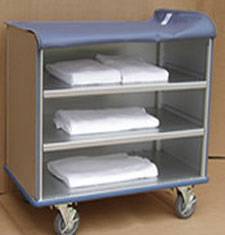Home » Hospital & Durable Medical Equipment » Considerations For Commercial Laundry Carts » Considerations For Commercial Laundry Carts
Considerations For Commercial Laundry Carts

Enclosed Aluminum Linen Cart - 3 Shelf
Retail Price: $2,995.90
Your Price: $2,134.62

Top Loading Enclosed Fiberglass Waste Collection Cart
Retail Price: $3,680.17
Your Price: $2,855.77

Fiberglass Enclosed Linen Cart - Dual Shelf
Retail Price: $4,422.99
Your Price: $4,096.15
There are many different styles and designs of laundry carts available for commercial use that are ideal for moving all types of linens between individual rooms and the laundry. Choosing more than one style of linen cart is a great option that gives staff the opportunity to select a cart that makes sense for the job. With multiple types and designs on the market thinking through exactly what the cart will be used for, the volume of laundry that needs to be moved and the specific designs of the rooms and laundry area will be an important first step.
Laundry carts that are ergonomically designed will assist staff in moving even the heaviest loads with ease. These carts typically stand slightly higher that a standard cart and which prevents the operator from having to bend over when pushing or turning the cart. It also places the bin higher up, limiting the need to bend over significantly to remove the contents. With a large capacity the zinc plated frame elevated basket carts are designed to easily move through hospital corridors, push on and off of elevators and even turn around in smaller spaces. A lightweight design makes these laundry carts practical and very user friendly. Large casters also help to ensure that staff will not experience difficulty when pushing the cart over any floor surface. This includes both carpeting and smooth surfaces as well as the transitions between.
Another option for user-friendly laundry carts is one that has a front load design. This means that the basket of the cart is lower in the front than in the back. Laundry can be easily loaded into the front of the basket since there is no need to lift it up and over a higher edge. In this type of design the front side of the cart is significantly lower than the back. This allows the larger and heavier items including blankets and wet towels to be loaded into the front of the basket and pushed towards the higher back without the need for lifting.
Unloading these types of laundry carts is also a breeze. The staff can pull rather than lift all the linens from the basket into the dryer. Large industrial front load machines are a perfect height match for these carts. Some of these basket styles of carts also have a pole rack that allows hanging garments on one or both ends of the cart. With the option to choose a narrow basket they are ideal for very small areas and rooms and can easily be moved between machines in the laundry.
These styles of commercial laundry carts are perfect for moving damp and wet materials as well as dry linens. The open design allows air circulation and prevents a damp smell from developing in the laundry even if damp items have to be left in the cart for short periods of time. The wire on these baskets is chrome so there is no need to be concerned about rusting or discoloration of the basket or frame.
A highly durable and extremely practical type of cart for moving soiled linens, bedding and other large items is an elevated laundry cart with a poly tub. These tubs are resistant to scratching, molding, staining and are very easy to clean and sanitize with all standard disinfectants. They are designed to be leak proof, ideal for moving soiled or wet bedding through the facility. The seamless bottom will catch any liquids or debris from the laundry then the entire bin can be quickly cleaned between uses.
All commercial carts should also be designed to be sturdy and resist tipping when moving or turning. The solid frames and casters set to the outside of the frame provide this protection and security. The very large bins may be designed to tip forward for easy unloading and cleaning. In these designs the front of the bin is not square but rather cuts up at an angle to provide a flat surface to easily tip the bin up and unload.














